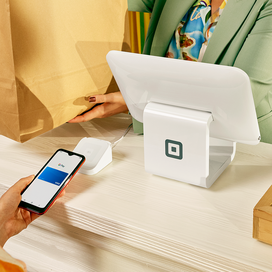Table of contents
Square cannot provide advice on tax issues. This article is for educational purposes and does not constitute legal or tax advice. For specific advice applicable to your business, please contact a professional.
For retail businesses that sell large-ticket items, such as furniture, offering lease-to-own arrangements can be a great way to grow your consumer base, offer a positive customer experience, and improve your average order value (AOV).
Traditionally used in real estate, the lease-to-own model has been growing in popularity with retail products that represent large, long-term purchases such as furniture, appliances, electronics, and mattresses. Lease-to-own agreements provide customers with some flexibility in committing to big-ticket expenses. While being able to enjoy the product right away, these purchases are also more financially feasible with the cost being spread out over a period of time.
Here’s what you need to know about offering lease-to-own to your customers, the benefits to your business, and what to consider before you get started.
What is lease-to-own and how is it different from buy now, pay later (BNPL)?
The lease-to-own payment option offers similar financial accessibility to consumers as the buy now, pay later (BNPL) model, which is also growing in popularity, although the two differ fundamentally in logistics and impact to a business.
Lease to own
In lease to own, there is an actual lease agreement between the business (as the lessor) and the customer (as the lessee). The consumer makes rental payments on the item for an agreed-upon period of time, after which the lease ends and ownership of the item transfers to the consumer. Throughout the lease period, the consumer is able to use the item as a rental, and anytime before the lease agreement ends, the consumer may decide to discontinue payments and return the item to the business.
A lease-to-own agreement is not a loan, as the consumer is not borrowing any money. They are renting a product from the business. Lease-to-own payments generally don’t require a credit check, making this accessible for consumers with low credit. The consumer typically pays a deposit upfront and can take the product home with them that day.
Buy now, pay later (BNPL)
BNPL, on the other hand, is a type of short-term loan in which the consumer borrows money for the total cost of the product and then pays off the balance in installments (often interest-free). BNPL financing is generally offered through a third-party provider that takes on the risk of payment collection, rather than the business itself. It can help a business reach more customers and get them to convert, providing the opportunity to then cross-sell and build loyalty for future revenue. In both models, the consumer typically pays a deposit upfront and can take the product home with them that day. Of note, while consumers take on an interest free loan but could incur fees for missed or late payments.If you are considering offering BNPL as a payment option, typically as the business owner you are paid instantly while your customers pay in installments to a third-party provider. Both appeal to consumers with low credit or tight budgets; lease-to-own generally requires no credit check, and BNPL often requires only a soft credit check.
What are the benefits of the lease-to-own model for your business?
Because lease-to-own arrangements allow consumers to access a big-ticket purchase instantly without putting up the full cost at once, this model can help your business reach a broader target market — including people who have unsteady income, poor credit, difficulty committing to large long-term purchases, or who desire flexibility. In a study from PYMNTS.com, 78.9% of respondents cited flexibility as their top reason for using lease to own. Millennials are moving around more often and renting homes for far longer than previous generations, and flexibility in things like furniture, appliances, and electronics is attractive for this consumer base.
Lease to own can be a great way to get customers in the door, convert them with a lower barrier to entry, and then turn them into long-term brand loyalists through positive customer experiences and personalized relationships with your brand.
Lease to own doesn’t just help your customers afford a big-ticket purchase, but often benefits the business financially as well. The trade-off of getting instant gratification is that consumers generally pay more in total for the item over the course of the lease agreement than they would have if they’d paid upfront in full, due to leasing fees that can help your business cover expenses.
Even more beneficial is the impact to your cash flow and inventory. Lease to own allows you to move products off the floor and rotate new ones in. When the high price tag can be a barrier to purchase, leasing out your products brings in a steady cash flow to your business. Even if a consumer rents for half of their lease period, and then returns the item, that product has brought in more revenue than it would have sitting on your showroom floor.
How to decide if lease to own is right for your business
Before jumping into lease-to-own agreements, assess your product line. This model works well if the products you sell are:
- Considered a large expense (something people may save up for and don’t expect to buy multiple of in the same year)
- Can be reused or sold as gently used
- Are generally kept for a long period of time (not items that people want to swap out often)
Lease to own can be a good fit for consumer goods like furniture, home appliances and furnishings, electronics and televisions, fitness equipment, and sporting goods.
Once you’ve determined that your product line fits the bill, conduct market research on your target demographic to determine if your consumers would be attracted to the lease-to-own model. Notably, assess whether there is a gap in your industry between consumer demand (or desire) for the products you sell and their ability to afford those items in full. This is generally a sign that lease to own may help make your products more accessible to your target market.
Analyze your competitors to see if others in your industry are offering lease to own, BNPL, or other financing options. Identify how you can position yourself to offer more value to consumers. Remember, it’s not always about competing on price. Lease to own is all about flexibility, so you may compete by offering more flexible payment options than your competition. Or, you may add value by including delivery and assembly or maintenance and repair services as part of your lease agreement.
Finally, calculate your costs and pricing strategy to see whether lease to own can be profitable for you. Research and draft a sample lease agreement. Be sure to do calculations for consumers who may rent the item for a time and end their lease agreement early, returning the product to your business. In those cases, where is the threshold where the cost/benefit analysis comes out in your favor? How likely is it that consumers will return the item early in their lease period?
Lease-to-own agreements are gaining traction in the retail space as consumers seek more flexibility and financial options for accessing big-ticket purchases. If you’re looking for ways to move more of your inventory, create steady cash flow, and increase average order value, offering lease to own may benefit both your business and your consumer.
![]()












